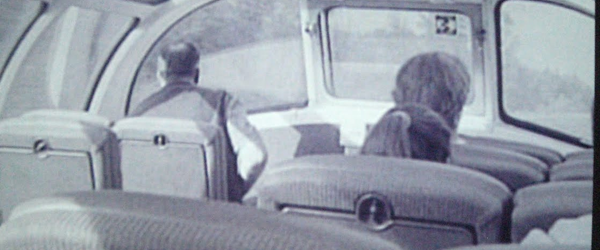
Sleeping Car, Monique Moumblow’s Phantom Ride
Film, ReviewsLong before rails were laid out on film sets to perform tracking shots, the train and cinema oftentimes found themselves on a mutual journey. The Louis Lumière short L’arrivée d’un train en gare de la Ciotat (1895), filmed with a fixed camera on a platform as a train pulls in, or the view from the engine front in Through the Haverstraw Tunnel (1897), are only the tip of the iceberg.
Both the up-and-coming cinema and the already fairly developed railroad industry showcased travels through space and time at a speed previously unknown to man. The early cinema’s preoccupation to capture movement by projecting a number of frames per second – initially about 15 or more, later on standardized to 24, as if to emulate the hours in a day – was ‘foreseen’ by train passengers who saw landscapes flashing by when they glanced through the carriage windows. While the railroad cars’ cadence would be reflected in the rattling of the camera and the projector, as well as in the rhythmic flow of successive shots.
Cinema’s momentum rapidly carried on into more narratively elaborated constructions. In A Kiss in the Tunnel (1899), British film pioneer George Albert Smith combined a studio shot inside a carriage with parts of a reel from a so-called phantom ride (filmed by a camera, and sometimes a camera man as well, strapped to the front of a moving unit, such as a locomotive).
G.A. Smith gave his audience, seated in darkened exhibition rooms, a glimpse of what an unknown man and woman might do when a tunnel would conceal them from the surrounding world. Thus extending the amazement for man’s mechanical mastery into the realms of emotion and imagination. And very swiftly arriving once again in the territories of sensorial attractions, albeit with the often somewhat veiled mediation of the metaphor.
With the famous final shot of his North by Northwest (1959), a shot that followed a love-scene between Cary Grant and Eva-Marie Saint, Alfred Hitchcock catapulted the well-known trope of a train passing through a tunnel into cinematic seventh heaven. ‘It’s a phallic symbol. But don’t tell anyone!’ a sardonic Hitchcock told French film magazine Les Cahiers du Cinema. There was no need to. The ‘train-in-tunnel’ shot became a much travelled path, a sexual innuendo that almost completely lost its suggestiveness.
Sleeping Car: we are all aboard.
Yet, the kinship between cinema and the train has all but reached its final destination. In her 2000 short film Sleeping Car, Canadian artist Monique Moumblow added her take on a liaison that has already lasted over a century.
Befittingly, Moumblow uses various (found and newly staged) images of trains – interiors and exteriors – to tell the tale of two lovers who have planned to meet somewhere along the railroad. Over the images runs a female voice-over (in Swedish). Gradually, the audio track and the English subtitles – recounting three scenarios of a lover’s meeting, in the future tense – are manifestly separated from each other, thus providing viewers with different accounts of possible worlds. Even for those who don’t understand Swedish. Will their tracks ever cross or forever run parallel, without ever intersecting?
The collected images, the voice of Swedish actrice Ingrid Thulin and the English subtitles written by Moumblow represent alternative narratives, but are combined in the same cinematic space. The five minute film seems to tell us that no matter what form of communication we choose, part of the message is always lost. In a private conversation between two people as well as in a work of art addressing an intended public of strangers. It would seem that viewers who don’t comprehend the Swedish voice-over miss a significant part of the film. Yet, the estrangement plays – equally or perhaps even more effectively (?) – on another level. The barrier that language often imposes on audiences of a ‘foreign film’ takes on unsettling proportions here, as Moumblow willfully targets miscomprehension. From the end credits we learn that the voice-over stems from Ingmar Bergman’s Winter Light (1962), in which the Swedish ‘master of ceremony’ harshly explores the possibility of a meaningful life in a godforsaken world.
Moumblow ends her short with an image of an empty bed with rumpled sheets in a train’s sleeping compartment. We are where the title card at the beginning of Sleeping Car said we were. As the train rattles on, we wonder if the meeting between the two lovers is past or future, illusion or disillusion.
Next stop: Sleeping Car (Monique Moumblow, 2000).























[…] Sleeping Car, Monique Moumblow’s Phantom Ride – ZOUCHCinema’s momentum rapidly carried on into more narratively elaborated constructions. In A Kiss in the Tunnel (1899), British film pioneer George Albert … Get the RSS Feed July 26, 2011 at 11:59 am by admin | Category: Uncategorized | […]